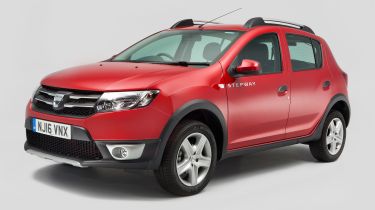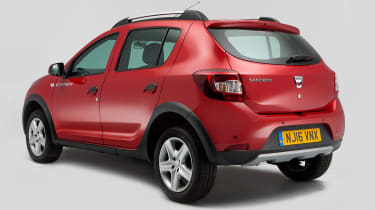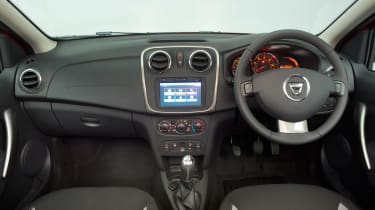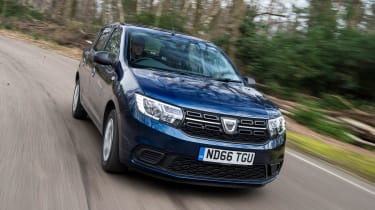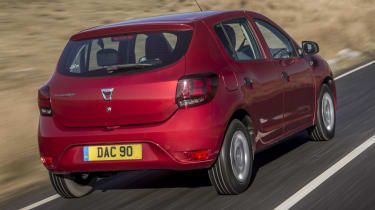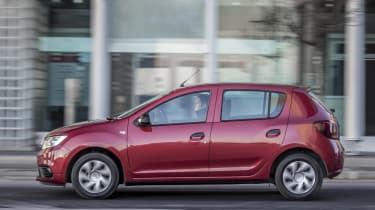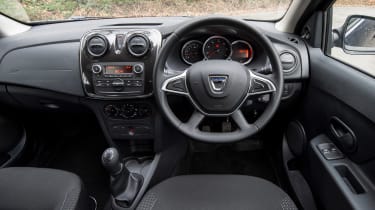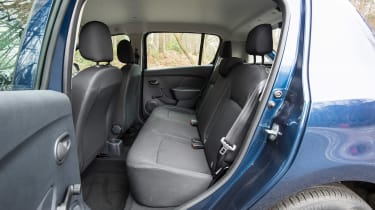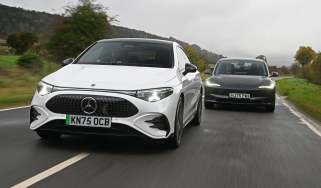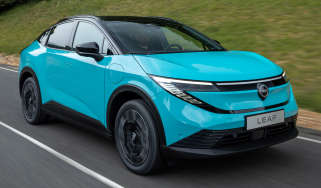Used Dacia Sandero (Mk2, 2013-2020) review: far more than just a low price tag
A full used buyer’s guide on the Dacia Sandero covering the Sandero Mk2 that was on sale in the UK between 2013 and 2020
Verdict
Due to its bargain price, it would be easy to dismiss the Dacia Sandero as an also-ran that could never rival the likes of the Peugeot 208, Kia Rio or even the DS 3. But the reality is that as an overall ownership proposition, it trounces these cars. While the Sandero’s engines are rather uninspiring, and basic editions offer little in the way of feelgood factor, there’s no denying the value the Dacia provides. So if you’re looking for cheap motoring but don’t want to compromise reliability, comfort or practicality, we’d recommend you get better acquainted with the Sandero.
British buyers love their premium models, so the idea of launching a budget car brand might have seemed crazy to many people when Dacia arrived here in 2013.
This Renault subsidiary started out as Romania’s national car maker 50 years ago, but was absorbed into the French giant’s portfolio in 1999. And it swiftly made waves by launching the UK’s cheapest car, in the shape of the sub-£6,000 Sandero.
But while this supermini follows Dacia’s template of providing reliable, practical transport on a budget instead of focusing on cutting-edge tech or design flair, there’s more to it than just a low price. The brand offers a range of engines, well equipped higher-spec models and a rugged-looking, crossover-style Stepway model. And owners tell us they love their Sanderos.
History
The first Dacia Sanderos hit UK dealers in January 2013. Buyers could choose from 73bhp 1.2 or 90bhp turbocharged 0.9-litre petrol engines, plus a 90bhp 1.5 diesel. At launch there were Access, Ambiance and Laureate trim levels, as well as the chunky Stepway, but in March 2015 a Laureate Prime was added. This new range-topping car had Cosmos Blue metallic paint, electric rear windows, upgraded interior trim and a seven-inch multimedia touchscreen.
Used - available now

2024 Dacia
Sandero
13,238 milesManualPetrol1.0L
Cash £11,857
2023 Dacia
Sandero
37,763 milesAutomaticPetrol1.0L
Cash £10,799
2022 Dacia
Sandero
30,247 milesManualPetrol-lpg1.0L
Cash £8,799
2022 Dacia
Sandero
23,966 milesManualPetrol1.0L
Cash £9,000Euro 6 engines were fitted from August 2015, cutting CO2 emissions and boosting fuel economy. In April 2016 an Ambiance Prime special edition was launched, with alloys, metallic paint and front foglights. A facelift in 2017 brought LED headlights and different bumpers.
Which one should I buy?
There’s only one bodystyle and one transmission option for all Sanderos, so it’s just a question of working out which engine and trim level suits you best.
Entry-level Access models feature steel wheels, black bumpers and manual windows. They don’t even have a radio, although they do get power-steering, ESP, tyre pressure monitors and a split rear seat. Move up to the Ambiance and there are body-coloured bumpers, more upmarket interior trim, remote central locking, electric front windows, Bluetooth and a radio.
The flagship Laureate has alloys, posher cabin trim, a trip computer, cruise control, air-con, heated and electrically adjustable door mirrors, plus height-adjustable front seats and seatbelts. The Stepway only comes in Ambiance and Laureate trims.
Alternatives to the Dacia Sandero Mk2
For the same money as a used Sandero there are plenty of alternatives, but they’ll generally be older and have higher mileages. The Hyundai i20 and Kia Rio aren’t the value buys they once were, but feature tempting warranties. Peugeot’s 207 and 208 are in plentiful supply, feel plusher than the Dacia and come with some excellent engines. The same is true of the Renault Clio. Also great value are the Ford Fiesta and Vauxhall Corsa; they feel posh compared with the Sandero, have wide ranges and there’s loads of choice.
What to look for
Spare wheel
If you have a puncture, you’ll need to use the tyre inflation kit that comes on all Sanderos. But dealers will sell you a spare wheel as an extra-cost option.
Gearbox
A five-speed manual is the only transmission option on the Sandero; Dacia doesn’t offer an auto. So if you like two-pedal motoring you’ll have to look elsewhere.
Boot sill dings
The loading sill for the boot on the Stepway is quite high and gets damaged easily. Stick-on protectors can be fitted, and are well worth investing in.
Headlights
Some owners haven’t been impressed by the output of the standard headlights so they’ve upgraded the bulbs. Osram Silverstars are a popular choice.
Interior
Not only does the Sandero offer more cabin and boot space than many rivals, trim quality is better than you might expect. Most cars have limited steering wheel and seat adjustment and entry-level models are best avoided as they’re spartan. The 320-litre boot expands to 1,200 litres with the seats folded.
Running costs
All Sanderos need servicing every 12 months or 12,000 miles. Costs vary according to the dealer’s location, but a minor check-up is generally priced £149-£169 and a major one £269-£299; services alternate between the two.
Similarly, the cost of extra jobs varies. For example, the brake fluid needs to be changed every 72,000 miles or four years at £39-£49, while fresh coolant is required every five years at £69-£89. The 1.2-litre engine has a cambelt that must be renewed every six years or 72,000 miles, while the 1.5 dCi’s belt stretches this to six years or 90,000 miles; the 0.9 TCe powerplant is chain driven. Expect to pay £389-£409 to have the cambelt replaced.
Recalls
Interestingly, although parent company Renault has issued no fewer than 24 recalls since Dacia was launched in the UK at the start of 2013, the budget brand itself has yet to launch any campaigns at all.
So while many of the Sandero’s Renault sister models have been called back to dealer workshops to resolve potential issues with their braking systems, fuel leaks, steering glitches and suspension failures, the Dacia supermini seems to be holding up pretty well.
Driver Power owner satisfaction
The Sandero made its first appearance in our Driver Power satisfaction survey in 2014, in 43rd place. It fell to 53rd in 2015, then rose to 30th this year. Running costs and reliability (ninth and 19th) were 2016’s highlights, alongside in-car tech (28th) and ride quality (38th). Seat comfort and build quality held the car back, at 91st and 87th respectively.
Dacia Sandero (2013-2020) review: what we said
Extracts from our test drive of the Dacia Sandero in October 2020...
If you're after no frills driving and aren't worried by the badge or desirability, then the Dacia Sandero offers excellent value for money.
No matter which trim you go for, the Sandero isn’t exactly sophisticated from behind the wheel. The interior does have plenty of space, but it's not the most luxurious place to be and the quality is questionable in places. That’s how Dacia manages to keep its prices so incredibly low, though, and plenty of canny buyers seem prepared to accept the car's flaws in the pursuit of a bargain.
The Dacia Sandero was the cheapest new car for sale in the UK. With a starting price well under £10,000, a new Sandero (as well as the Sandero Stepway) rivalled used cars for value for money.
While the price is less than you'll pay for a city car, the Sandero is supermini-sized, which makes it a top choice for buyers needing a practical car on a budget. In terms of size, the Sandero rivals the likes of the Renault Clio, Skoda Fabia and Hyundai i20, although prices still undercut the smaller Kia Picanto and Hyundai i10.
Under the skin, the Sandero uses running gear from parent firm Renault, which is why it can be sold at such a low price. The entry-level Access trim has been dropped from the price list, so there are just two specifications to choose from: Essential and Comfort. Dacia also offers the Sandero Stepway - a Sandero with SUV-style body cladding, roof rails and a raised ride height.
Engines, performance and drive
On the road, the Dacia Sandero doesn’t really do much wrong, although you’ll never really enjoy driving it. Despite its elderly Renault Clio underpinnings, the Sandero rides well and has decent grip. However, kickback through steering, limp gearshift and poorer refinement betray the car’s nineties mechanical roots.
Still, the ride quality is really impressive. This is down to the relatively small wheels and high-profile tyres, and the fact that Dacia never set out to give the Sandero sporty responses.
0-62mph and top speed
When you read the story behind its development, you’d think all the Sandero has to offer is decade-old Renault tech that’s well past its sell by date. But that’s not quite the case. While the chassis is old, the 900cc TCe turbo three-cylinder is bang up to date. This is a thoroughly modern unit, essentially designed by Renault to replace the old 1.2 in its more modern cars – you can find it in service in the likes of the Clio and Captur. In the Sandero it produces 89bhp and offers reasonable acceleration, with 0-62mph reached in 11.1 seconds
It’s a lightweight, hi-tech engine with advances such as a light-pressure turbo and multipoint fuel injection. And in use it revs freely and is very willing, not to mention more refined than the entry-level engine. Mind you, that refinement from under the bonnet does show up how noisy the Sandero is in other areas, with tyre roar and wind noise letting the side down. Power delivery could be smoother, but it revs eagerly, pulls strongly and emits a characterfully thrummy soundtrack.
The basic 1.0-litre petrol engine needs working hard, although it's just about acceptable as long as you don’t ask too much of it. For those who buy Sanderos for short journeys, or just bumbling around town, its 74bhp output will be fine, but start extending it on motorways or main roads, and you’ll soon find that it struggles to keep pace with traffic.
The 1.5 Blue dCi diesel is no longer available, instead Dacia has added the 1.0-litre TCe 100 Bi-Fuel to the lineup. This is a dual-fuel petrol and LPG engine producing 99bhp and 160Nm of torque, with drivers able to switch between the two fuels at the touch of a button on the dashboard.
Dacia claims that the new engine will deliver enhanced performance due to more torque and reduced fuel costs for customers - while also delivering lower emissions.
MPG, CO2 and running costs
In terms of economy, there's little to separate the two petrol engines - the 89bhp 898cc TCe petrol turbo returns 47.0mpg, with CO2 emissions of 134g/km, while the 74bhp 1.0 SCe improves on this slightly, delivering 48.7mpg and 130g/km.
The lethargic 1.0 SCe model is only offered in base spec Essential trim, so unless you're searching for the ultimate in cost-efficiency, the extra outlay on the TCe unit will be worthwhile, as the SCe is particularly slow and noisy. But for young drivers, the low insurance group will make all the difference. The TCe 100 Bi-Fuel LPG unit delivers a maximum 49.5mpg, with CO2 emissions of 116g/km.
Interior, design and technology
Anyone who has driven a Renault hatchback from the late nineties or early noughties will feel right at home inside the Dacia Sandero. The instruments appear to be taken from a 1999 Clio, the column stalks from a 2001 Scenic, and the hazard lights and central locking buttons from an old Laguna. It would be unforgivable from other brands, but this is exactly how Dacia keeps its prices so low. Everything works fine, so why would you worry about where it comes from or what it looks like?
The same goes for overall cabin quality. Given its price, you’d expect the Dacia to feel basic. The materials aren’t up to Ford standards, but a new steering wheel and trim inserts help lift otherwise utilitarian feel. The plastics in the dash are functional, rather than pleasing to touch – they’re there to hold the instruments and switches in place, and to cover up the heating and electrical systems. If you want any kind of high-grade, soft-touch materials, you’ll have to look elsewhere and dig deeper into your pockets.
A facelift in 2017 has added new lights and bumpers to the Sandero, so it's looking a bit less tired these days – although the changes are pretty minor overall.
The Essential trim offers manual air-con and front electric windows, while buyers wanting rear electric windows, an upgraded steering wheel and a front central armrest will have to opt for the top Comfort models and then pay extra to add the Comfort Pack.
Sat-nav, stereo and infotainment
While Essential spec includes a DAB stereo system, Comfort versions add a modern touch with rear parking sensors and the brand’s MediaNav touchscreen sat-nav. The seven-inch display features smartphone connectivity, too, including Apple CarPlay and Android Auto.
Practicality, comfort and boot space
While the Sandero isn’t the biggest car in the world, Dacia’s designers have come up with a good packaging compromise that sees it deliver a reasonable amount of interior space.
The car is four metres long exactly, which is only very slightly longer than the late nineties Clio on which it’s based mechanically. But the Sandero is quite broad, measuring 1.7 metres wide (not including the wing mirrors). This obviously helps cabin space, although it’s still a relatively compact car, and few drivers will have any trouble squeezing it into a tight car park space.
Leg room, head room & passenger space
One of the major drawbacks of the Dacia Sandero will become apparent to tall drivers and front seat passengers about an hour into any long journey. The front seats – again taken from a Renault Clio from the turn of the century – are quite narrow across the base and force you to adopt a slightly perched up position. This means it doesn’t take long for backsides to become numb.
Shorter, slimmer occupants won’t notice it quite so quickly, but it’s one of the areas where we wish Dacia had invested a bit more; most customers would surely be prepared to pay a little extra for more comfort. At least both the Essential and Comfort spec offer a height-adjustable driver's seat.
Space in the back isn’t all that great – you can tell that the Sandero is based on an older platform, as modern rivals leave it trailing by some distance in this respect. Taller children will soon complain about the limited space, while it can be a struggle to squeeze in bulky child seats. It's also worth noting that Access cars do without rear headrests, which further compromises rear seat comfort.
Boot
The 320-litre boot capacity is very generous considering the relatively small exterior dimensions of the Dacia Sandero. All models get a 60:40 split rear seat, but only the seatbacks split and fold; the base is fixed. Even so, when you drop the backs, you free up an impressive maximum load space of 1,200 litres, which is almost as much as you’d expect to find in a compact van.
Did you know you can sell your car through Auto Express? We’ll help you get a great price and find a great deal on a new car, too.

